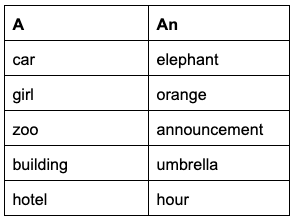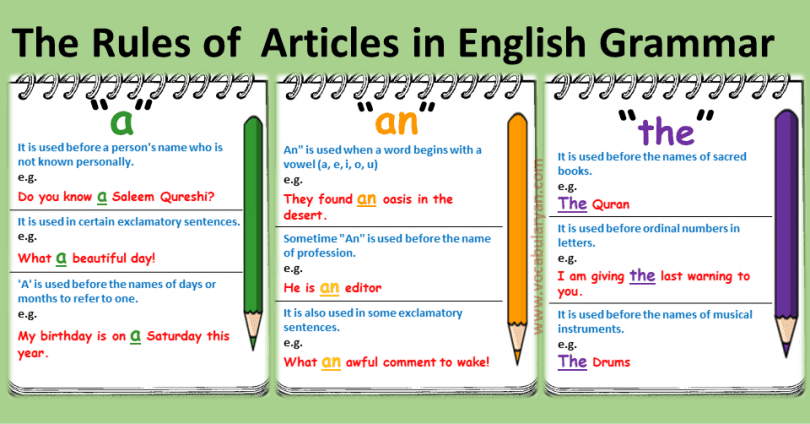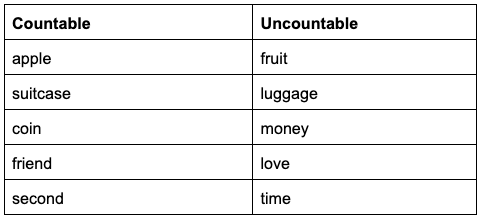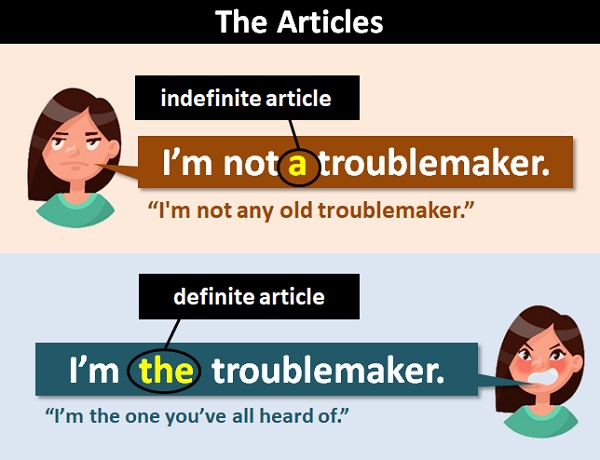What is an article?
Articles are a type of determiner. They function like adjectives, as they modify the noun in the sentence. The only articles in English are ‘the’ and ‘a/an’. Yet, the tricky part is that we use them differently – and sometimes not at all.
We call ‘the’ the definite article and ‘a/an’ the indefinite article.

When to use a/an, the and no article
So when do we use articles in English? We’re going to show you some explanations, examples, and activities to practice so that by the time you finish reading, you’ll be an articles pro!
Definite and indefinite Articles

We use ‘the’ before a noun when:
-
- referring to something specific
-
- there is only one of something (e.g. the cathedral)
- the noun has been mentioned before
We use ‘a/an’ before a noun when:
-
- referring to something in general
-
- mentioning something for the first time
- describing someone’s profession (eg. I am a teacher)
Compare these two sentences:
Let’s watch the TV series that we love (a specific TV series that is familiar to us or that we know about.)
Let’s watch a TV series after dinner (we don’t have a specific TV series in mind – it could be any series.)
It’s important to remember that we use ‘a’ and ‘an’ differently: ‘a’ comes before a noun beginning with a consonant sound and ‘an’ comes before a noun beginning with a vowel sound. For example:


Here are some more examples of definite and indefinite articles:
-
- Somebody call a policeman!
-
- Did you see the film that was on Channel 4 last night?
-
- Would you like a glass of milk?
-
- I love to swim in the ocean.
No article
We never use a/an with uncountable nouns. However, ‘the’ is sometimes used with uncountable nouns in the same way it is used with plural countable nouns. This is when we want to refer to a specific object, group, or idea.
For example:
-
- Electricity has become more expensive recently.
- Can you pass me the sugar, please?
It’s a good idea to familiarize yourself with countable and uncountable nouns so you can make the right choice of article. See the table below for examples.

Check out some of the following situations for knowing where you must leave out the article.
Use ‘no article’ before:
-
- Names of languages and nationalities: Chinese, Russian (unless referring to the population of the place e.g. ‘The Italians are known for their delicious food.’).
-
- Names of sports: cricket, baseball.
- Names of subjects: Art, Mathematics.
Geographical places
When it comes to geographical places, such as countries or continents, we use ‘the’ in some cases and no article in others. Unfortunately, there aren’t any rules to help you here – you just have to familiarise yourself with the ones that need ‘the’ or not.
Do NOT use ‘the’ before:
-
- Lakes: Lake Geneva, Lake Placids
-
- Mountains: Mount Fuji, Mount Everest.
-
- Continents: Europe, Asia.
-
- Most countries: England, Sweden.
- Counties/states/provinces/regions: Oxfordshire, Catalunya etc.
-
-
- Rivers: The Nile, The Mississippi.
-
- Cities, towns, villages: London, Paris.
-
- Islands: Bali, Hawaii.
- Street names: Main Street, 5th Avenue.
Use ‘the’ before:
-
- Rivers: The Nile, The Mississippi.
-
- Mountain ranges: The Andes, The Pyrenees.
-
- Deserts: The Sahara, The Atacama.
-
- Oceans and seas: The Pacific, The Mediterranean.
-
- Groups of islands: The Maldives, The Seychelles.
-
- Some countries: The USA, The Netherlands.
-
- Points on the globe: The Equator, The North Pole.
- Geographical areas: The Middle East, The West.
-

Types of Articles with Examples
Definite Article
Definite means to be clear, exact, or obvious about something. It is called definite because it is used in relation to a particular thing or person. “The” is the definite article in English, which is used to refer to particular nouns, the identities of which are known. The definite article indicates that the noun is specific. The speaker talks about a particular thing.
For example:
- The cat sat on the couch.
- The dog attacked me and ran away.
Other examples are listed below:
- I’ll pick you up at the airport.
- We spent all day at the beach.
- Let’s go to the movies this evening.
- I have to go to the bank and get some Euros.
-
I really enjoyed the book I’ve just finished reading.
-
Do you like the other kids in your class?
Indefinite Articles
Indefinite means something which is not clear, obvious, or exact. They are called indefinite because the identity of the thing or person being spoken about is left unclear or indefinite. The indefinite article indicates that the noun is not someone or something in particular. The speaker talks about anyone of that type of things. The indefinite articles in English are “a” and “an.”
For example:
- Do you have a pencil?
- I want to have an apple.
Other examples are listed below:
- I’ve bought a car.
- She’s got a boyfriend.
- There was a sudden loud noise.
- What a shame that you couldn’t go to the party.
- I heard a child crying.
- He applied to become an American citizen.
- Chris has an evening job as an office cleaner.
- That was an excellent meal!